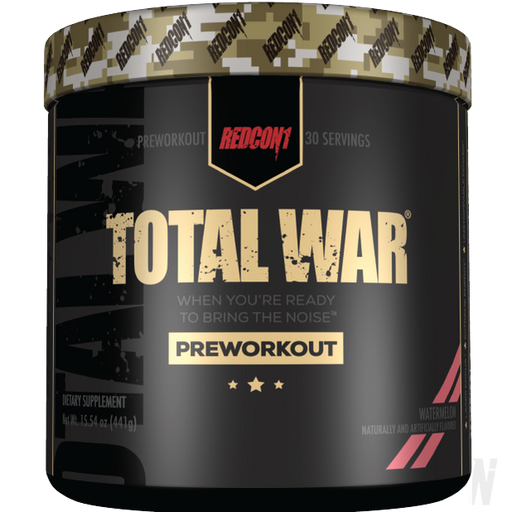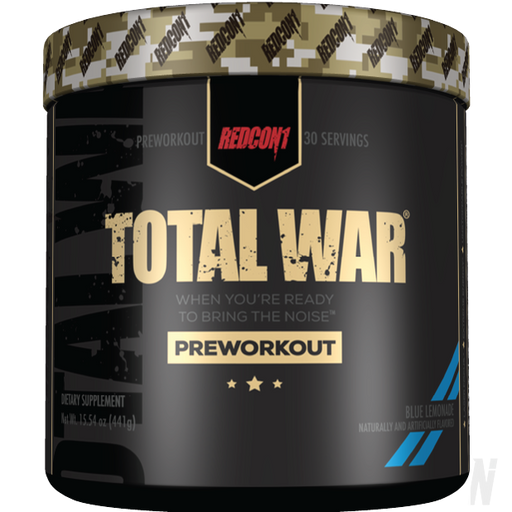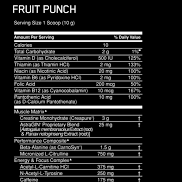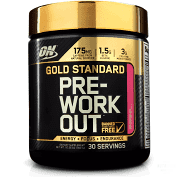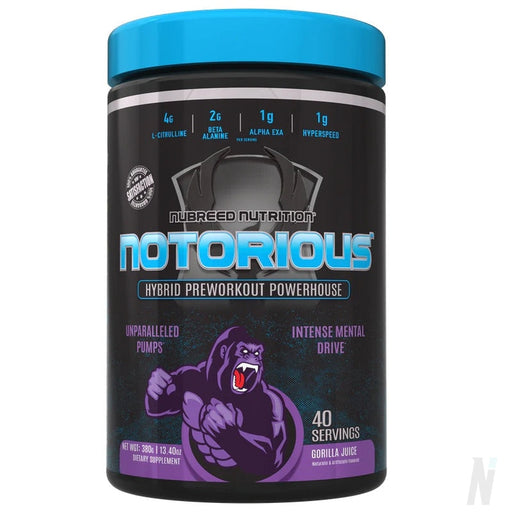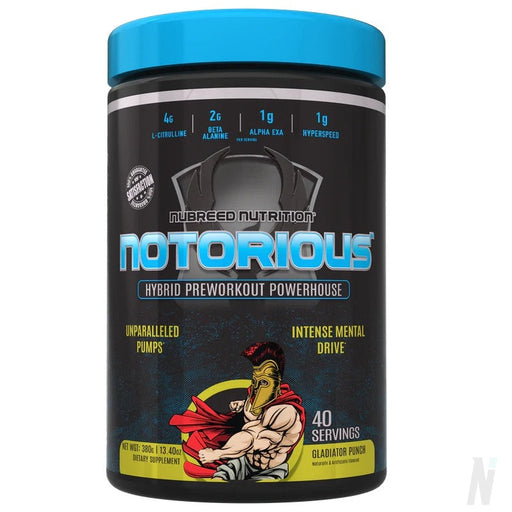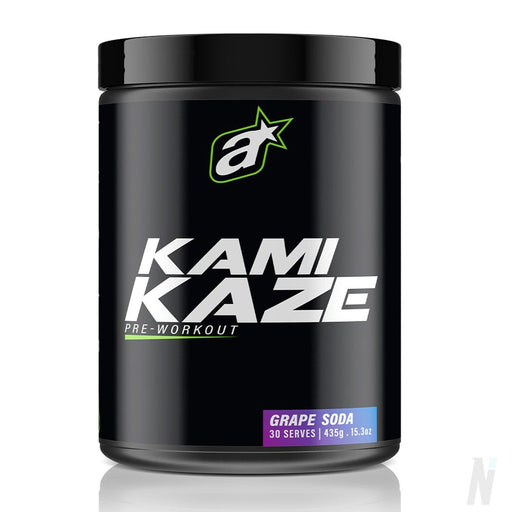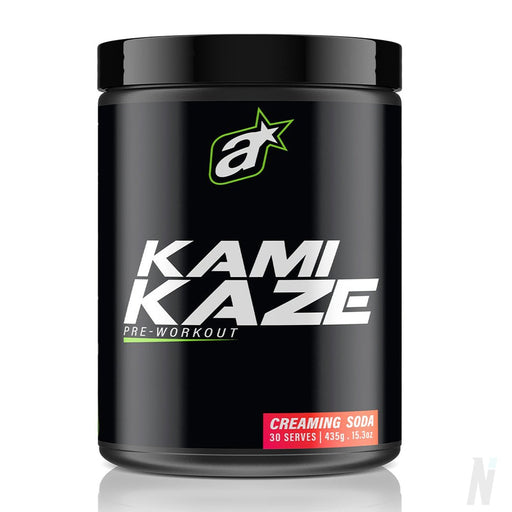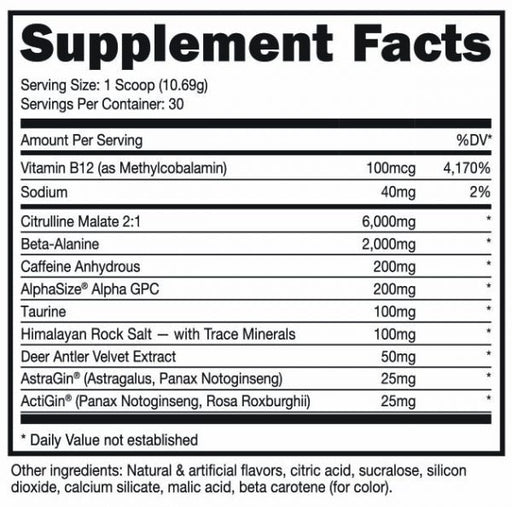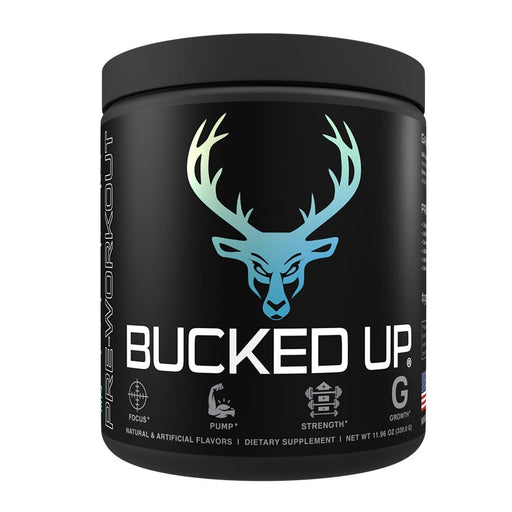Arms Race Nutrition Daily Pump
A good Pump formula should be straightforward: the ideal ratio of substances that are carefully chosen to increase strength, endurance, and pump, along with a complete, non-stimulant powerhouse blend. Well… It ought to be, but it's not. Therefore, fortunately for you all because Arms Race Nutrition will go above and above for you! Creating a brand-new category for "pump" products with ARMS RACE DAILY PUMP. With no stimulants or jitters, DAILY PUMP features cutting-edge, patented substances to optimise ALL performance aspects of your workout.
Non-stimulant pre-workouts often have just one goal: to increase localised blood flow. In other words, give a "pump." However, not all "pump" products are created equal, and you are frequently left wondering whether you achieved the goal you trained for. There is no ambiguity with DAILY PUMP, and with a brand like Arms Race Nutrition, we have faith that their products will consistently deliver as promised!
-
ATHLETIC PERFORMANCE. DAILY PUMP contains vital ingredients such as L-Citrulline (5g), GlycerSize™ (3g), and NO3-T® (2.5g) demonstrated to increase vasodilation and markers of athletic performance.
-
GREAT PUMP. DAILY PUMP’s key ingredients have also been shown to increase localised blood flow, causing a significant “pump effect.
- GREAT FOR EVERYONE. DAILY PUMP has been formulated to address a wide range of athletic needs. DAILY PUMP is perfect whether you’re an aspiring marathoner, a crossfitter, or someone just trying to get in shape.
L-Citrulline is well-known to increase blood flow, but it also increases peak power output. ViNitrox™ a trademarked polyphenol blend, has been shown to over blood vessels and drive nitric oxide into the bloodstream. What does this mean? It means that each ingredient in DAILY PUMP facilitates the dual purpose behind the performance pump: delivering you the gratifying feeling of a pump, but also servicing your goal of progression.
Arms Race Nutrition DAILY PUMP’s main emphasis is what we call a “performance pump” – that is, increasing localized blood flow with a purpose. And the purpose is to deliver real, measurable increases to key markers in exercise physiology, such as total time to exhaustion and peak power. We achieve the performance pump in DAILY PUMP by including ingredients that not only increase vasodilation thus inducing the “pump” effect – but do so while delivering real performance benefits.
FULL SCIENCE
You’re watching the clock, waiting for it to strike 12 noon. What is the significance of 12 noon? Well for some this is break time, lunch time, the time to take it easy for a little bit. Not for you though! For you, this is the time to put in work, get sweaty, lay those bricks that will build the wall of gains! Everyone has their tools to success. A pep talk, the lucky underwear, you name it. For you though its none of those things. You need an elixir that will surely give you the kick in the pants to do not 1 more rep, but 5 more reps. Not 1 more lap but 10 more laps. What is this is elixir I’m referring to? Well, its ARN HARNESS of course!
What is HARNESS? HARNESS is a precise mixture of key ingredients that enhance athletic performance and bring your workouts to the next level. For athletic performance, caffeine anhydrous, Zum- XR™, l-citrulline, beta alanine, ElevATP™, and L-Tyrosine are included at, or above, serving sizes suggested by the research. Together, these ingredients have been repeatedly demonstrated to increase maximum voluntary contractile force and other measures of power output, increase maximal oxygen uptake capacity, and significantly enhance time measures in standard athletic trials. For mental capacity, clarity, and focus, citicoline and Huperizine A are also included at, or above, serving sizes suggested by the research. Studies using these ingredients have shown them to increase working memory, reduce cognitive inhibition, and reduce neurological processes typically associated with cognitive decline.
With this blend of ingredients working synergistically together, our performance and focus blend is all you need to take the reins and HARNESS everything you need to take your workouts to the next level. Are you ready?
L-Citrulline
Citrulline is a non-essential, non-protein amino acid that forms during the urea cycle and forms ornithine when combined with carbon dioxide. Citrulline is also a critical source of endogenous (natural) arginine, as it is rapidly and efficiently converted to arginine in the vascular endothelium and other tissues.
Citrulline’s benefits have been shown to be greater than its parent compound. While arginine undergoes direct hepatic (liver) metabolism through the enzyme arginase, citrulline bypasses hepatic metabolism entirely and it is delivered straight to the bloodstream. The result is that gut absorption and plasma (blood) bioavailability studies comparing citrulline and arginine have shown two things. First, that citrulline is less readily destroyed and has greater absorption than arginine. Second, that citrulline supplementation increases arginine levels more effectively than arginine supplementation itself.
This translates to promising results. For example, animal studies show a significant increase in anaerobic performance at a 250mg/kg/day serving of citrulline, while studies in humans implicate citrulline in both aerobic and anaerobic performance increases. As a critical part of the urea cycle, citrulline’s performance benefits are thought to be a result of its role in ammonia clearance. Citrulline is implicated in reducing the oxygen cost of muscle processes, along with increasing the rate of post-exercise ATP and phosphocreatine replenishment. As ATP and phosphocreatine are the body’s ‘exercise fuel,’ this may result in citrulline delaying time to exhaustion in aerobic and anaerobic exercise.
Beta-Alanine
Carnosine is a bit of a misunderstood compound. We know that it is crucial for muscle function, and that dietary sources of carnosine are essential, but we don’t know precisely how it works. Moreover, for decades, we had no idea how to increase intramuscular concentrations of carnosine, as exogenous sources degraded in the body so quickly that it seemed to be effectively useless.
Enter beta-alanine. Simply a different iteration of one of the amino acids that comprises carnosine itself (alanine), beta-alanine has proven to be the most effective means of significantly increasing intramuscular concentrations of carnosine – and therefore of promoting all of carnosine’s various beneficial effects on muscle performance. If that weren’t enough, beta-alanine has also demonstrated beneficial physiological effects independent of its parent compound. In order to understand why, though, we need to first understand some of the basics behind carnosine itself.
Carnosine, a cytoplasmic dipeptide synthesized from the precursors L-histidine and l-alanine, is present in high concentrations in skeletal muscle and plays a pivotal role as a “chemical buffer” in myocytes (muscle cells). It has long been known that carnosine concentrations are highest in glycolytic muscle fibers (explosive) rather than oxidative muscle fibers (endurance) and thus long hypothesized that this amino acid is required for sustained performance during supramaximal exercise. Recent research demonstrates that carnosine exerts its physiological effects in long hypoxic (low oxygen) drives by functioning as a high-capacity pH buffer in skeletal muscle, preventing the pH ratio of plasma from dropping too low – and therefore preventing crucial pH-dependent processes such as protein synthesis from being inhibited by acidosis.
Despite its critical role in skeletal muscle anaerobic performance, intramyocellular synthesis of carnosine is rate-limited by the availability of l-alanine. Unfortunately, the majority of literature demonstrates that attempting to increase intramuscular levels of carnosine via either direct carnosine or alanine supplementation is largely ineffective due to carnosine/alanine pharmacokinetics. Enter beta-alanine. Research with beta-alanine demonstrates consistent and dose-dependent increases to intramuscular carnosine concentrations with beta-alanine supplementation, with certain studies showing an increase of 40-60% with chronic administration. These same writings reveal a synergistic effect of exercise on beta-alanine supplementation, whereby the muscles adaptive changes associated with resistance training promote further intramuscular carnosine production in response to beta-alanine supplementation.
In simpler terms, this essentially means that beta-alanine is a dietary supplement that promotes its own effects in combination with exercise. As you exercise, you simultaneously intensify beta-alanine’s physiological actions – both directly, as well as in the production of intramuscular carnosine. Once ingested, beta-alanine’s exercise-specific beneficial activity is well-established. Elevation of intramuscular carnosine content via beta-alanine supplementation has been shown to improve performance in the following ways.
- Both acute and chronic increases in total work capacity, measured by total volume during exercise sessions.
- Highly significant increases to TTE (total time to exhaustion), one of the most accurate and comprehensive measures of endurance. In various trials, beta-alanine supplementation has been shown to increase TTE by upwards of 20%.
- Increases to total muscle power output in both acute and chronic trials, suggesting that beta-alanine’s most significant benefit is to those engaging in power-dependent resistance training.
In total, a significant body of research exists to suggest that beta-alanine may significantly increase muscle power output, strength, training volume and output, overall performance in hypoxic (oxygen-deprived) conditions and peak VO2 max (oxygen holding capacity).
These myriad benefits make beta-alanine both one of the most-studied, and most well-rounded dietary supplements. Beta-alanine not only has direct, actionable physiological effects, but also promotes critical muscle physiologic adaptations that promote its own effects.
L-Tyrosine
Tyrosine is amongst a class of amino acids known as ‘non-essential’ amino acids, so called because the body can produce them endogenously, and it is therefore not essential to consume dietary tyrosine. That said, tyrosine is also what is known as a conditionally-essential amino acid; conditionally-essential because, along with glucose and ammonia, the synthesis of tyrosine additionally requires adequate levels of phenylalanine. Once synthesized, tyrosine is one of the most critical amino acids, given its prominent role as a substrate in the synthesis of the catecholamines dopamine, norepinephrine, and epinephrine, in addition to both T3 (triiodothyronine) and T4 (thyroxine) thyroid hormones.
In studies on stress modulation, tyrosine has been demonstrated to reverse stress-induced norepinephrine depletion and the depressant-behavioral effects normally associated with it. In simpler terms, tyrosine may, in certain conditions, dampen the extent to which norepinephrine is removed from the bloodstream during a stress event. In simpler terms still, tyrosine may help to mitigate the sense of depletion and fatigue felt at the end of a workout.
Tyrosine may also play important metabolic functions, mostly related to its role in synthesizing compounds which stimulate the nervous system. While not traditionally considered a sympathomimetic amine, studies which have coadministered tyrosine and stimulants demonstrate a synergistic effect. These studies suggest that tyrosine may potentiate the effects of both endogenous and supplemental norepinephrine and its mimetics (in the case of exogenous use) with respect to lipolysis, thermogenesis, and energy expenditure. Meaning that tyrosine may play a role in assisting norepinephrine to break up triglycerides and increase body heat transiently.
ViNitrox™ [Grape Extract (as Vitis vinifera) (Marc) and Apple Extract (as Malus pumila) (skin)]
ViNitrox™, a unique blend of grape and apple polyphenols, has been studied extensively for its benefits on performance. Polyphenols have often been touted for their ergogenic benefits on exercise and recovery. During endurance events, often involving high intensity exercises, the body generally becomes fatigued and no longer able to perform at the highest capacity. Muscle fatigue is often multifactorial and often associated with physiological parameters such as reduced neural input, the buildup of lactic acid, and the production of oxidative free radicals. These factors can negatively impact exercise performance. Polyphenols are compounds known to provide free radical fighting antioxidants that can mitigate this oxidative stress placed on the body during these events. These polyphenols have also been shown to increase nitric oxide levels in the blood, which has a direct correlation to power output and muscular strength. Nitric oxide is a natural molecule that has the primary job of inducing vasodilation, or the widening of blood vessels. When blood vessels dilate it allows for more blood flow to the working muscles as well as lowering of blood pressure. This allows for more nutrient rich blood to be delivered in a more efficient manner, which can increase muscular strength and endurance through the duration of the event. Several studies have been conducted on ViNitrox™ efficacy and have shown promising results. One study conducted on 50 athletes concluded that the athletes taking 500mg of ViNitrox™ per day showed both increases in physical training time (10%) as well as a significant decrease in oxidative stress (74%). These results are promising for ViNitrox™’s benefits when it comes to overall improvements in training outcomes.
Caffeine Anhydrous
Caffeine is one of the most widely consumed, and perhaps one of the most reviewed, psychoactive compounds. Its physiological effects in a range of areas have been well-documented, including exercise performance, information processing, alertness and mood enhancement, attention, and awareness, along with its anti-lipogenic and lipolytic abilities.
Most importantly to HARNESS, caffeine has been shown to have significant effects on exercise performance, even with ingestion in servings as small 3 to 9mg/kg/bw/day (the equivalent of 2 cups of standard coffee, for a 170lb male). In endurance training, possible explanations for caffeine’s performance-enhancing effects lie in its metabolic effects on both lean and fat tissue. It is suggested that caffeine’s potent lipolytic (the breakdown of fat tissue into fatty acids) and oxidative (the actual ‘burning’ of fat) action allow the body to utilize these sources during prolonged submaximal exercise. As a consequence, muscle glycogen is spared and available for use later in the training session. Practically speaking, this means caffeine is forcing your body to preferentially use fat tissue as a fuel source, while sparing the glycogen which gives you the full-bodied look!
In short-term exercise, caffeine’s demonstrated role in the inhibition of cyclic AMP- phosphodiesterase’s (PDE), adenosine receptor antagonism, and adrenoreceptor agonism come into play. These three pathways collectively stimulate lipolytic activity, boost fat metabolism, increase metabolic rate and energy expenditure, and regulate the body’s thermogenic activity. The practical results of activating these pathways are increases to the contractile force of both cardiac and skeletal muscle (harder flexion), an increase in energy expenditure (freeing up more caloric energy to be used in contraction), dilation of vasculature (better blood flow), and improvements to both nitrogen retention and skeletal muscle protein synthesis (key components to muscle building).
In ARN HARNESS, we have included a per-serving amount of caffeine that is neither excessive, nor arbitrary, but that instead reflects the servings used in clinical research.
Citicoline (Cytidine 5’-diphosphocholine)
Choline is an essential nutrient involved in numerous metabolic pathways, including DNA regulation and repair, protein function, and metabolism. Perhaps most importantly, the critical neurotransmitter acetylcholine is produced directly from free choline via cholinergic neurons. Acetylcholine is then responsible for a number of functions itself, most crucially as the compound which induces muscular contraction, and as the neuromodulator partially responsible for modulating risk/reward, arousal, and enhancing memory.
Choline’s essential role as a substrate for acetylcholine, and therefore brain development, is well documented in animal models. These studies demonstrate that levels of free maternal choline have a direct and fundamental impact on prenatal brain development, with the enhancements or deficits lasting into adulthood. Choline’s enhancing effect is particularly prominent in the hippocampus. In humans, the hippocampus is primarily involved in the consolidation of memory (taking short, episodic memory and translating it into long-term memory) and the learning of new information. Acetylcholine is a critical component in these processes, as mentioned above, and choline may therefore play a potential role in these processes as well by providing the substrate for acetylcholine synthesis.
Citicoline (Cytidine 5’-diphosphocoline), also known as CDP-choline, is a potentially superior form of choline due to its ability to cross the blood brain barrier. In fact, most studies with neurological or nootropic effects used this form. In that regard, studies in otherwise healthy, normal adults demonstrated meaningful and statistically significant impacts on working memory, recall, and attention.
ElevATP™ (Ancient Peat and Apple Extract) (fruit)
Adenosine triphosphate and other ATP metabolites are involved in a number of biological processes including cardiac function, blood flow, muscle contraction and neurotransmission. ATP is the primary molecule that acts as a carrier for energy within cells. It has also often been studied that increased levels of ATP have shown increases in health and performance. Supplementation with exogenous ATP has often shown its ability to increase ATP concentrations in blood. Oral supplementation with ancient peat and apple extracts have exhibited their ability to increase intracellular and intramuscular ATP levels. ElevATP® is a blend these specific polyphenols that works to increase endogenous ATP levels without a simultaneous increase in serum lactate. The significance of this is that usually with an increase in endogenous ATP there is an increase in intracellular free radicals. When these free radicals are not present, oxidative stress is mitigated and there is more potential for the beneficial increases in ATP to take center stage. These increases of ATP are essential as when available energy is increased it can have positive benefits in terms of increased power, strength, and overall exercise performance. One study in particular looked at dosing ElevATP® against placebo and showed that the group who received ElevATP® saw a blood ATP increase of 45% on average along with no increase in oxidative blood glucose. This type of result has been shown repeatedly in studies and has given ElevATP® the reputation to be a beneficial compound for the goals of improving endurance, strength, power, and other training specific adaptations.
ZumXR™ XR Caffeine
Züm-XR is a patented coating technology that allows the dissolution profile of certain ingredients, primarily caffeine, to have a longer lasting effect in blood serum levels. The release of those ingredients is initiated by an abrasion in the stomach and pH levels between the stomach and the upper gastrointestinal tract. The coating of the microbead technology is a patented timing system with pharmaceutical grade safe polymers. Comparatively speaking, the dissolution profile of Züm-XR caffeine to your typical immediate release caffeine showed that Züm-XR took a far greater amount of time, well over 120 minutes to complete the process of dissolution.
Huperzia serrata Extract (leaf and stem) (1% Huperzine A)
Huperzia serrata is a compound found in the plant families of Huperziaceae, Lycopodiaceae, and Selaginella and is endemic to China. The Lycopodium alkaloid Huperizine-A, found in ARN Harness, was first isolated from a folk medicinal preparation in 1984.
Due to the potent anticholinesterase activities of Huperzine A, the compound was been evaluated in numerous in vitro, in vivo, and human trials. These data suggest that Huperzine’s Ache activities are most potent in the cortex, hippocampus, and striatum (at least in rats) – key regions in the brain responsible for forming, coordinating, and recalling memory. These effects are assisted by Huperzine A’s high oral bioavailability. Studies using microdialysis technique in rats, for example, showed that the response to Huperzine A was dose-dependent and substantially lowered the level of ACh in cortex.
Huperzine A has also shown promise in humans. Used as a reversible inhibitor of acetylcholinesterase, Huperzine A has shown positive benefits on cognition and as a therapy for individuals suffering from Alzheimer’s Disease. This is partly due to its inhibitory factors on acetylcholine but also its neuroprotective properties. In another study on memory and learning performance, 34 pairs of middle school students complaining of memory inadequacy were given a small dose of Huperzine A. The students were then match paired along a number of vectors and provided tests on working memory. The results of this study exhibited that Huperzine A markedly improved the memory function of adolescent students.





